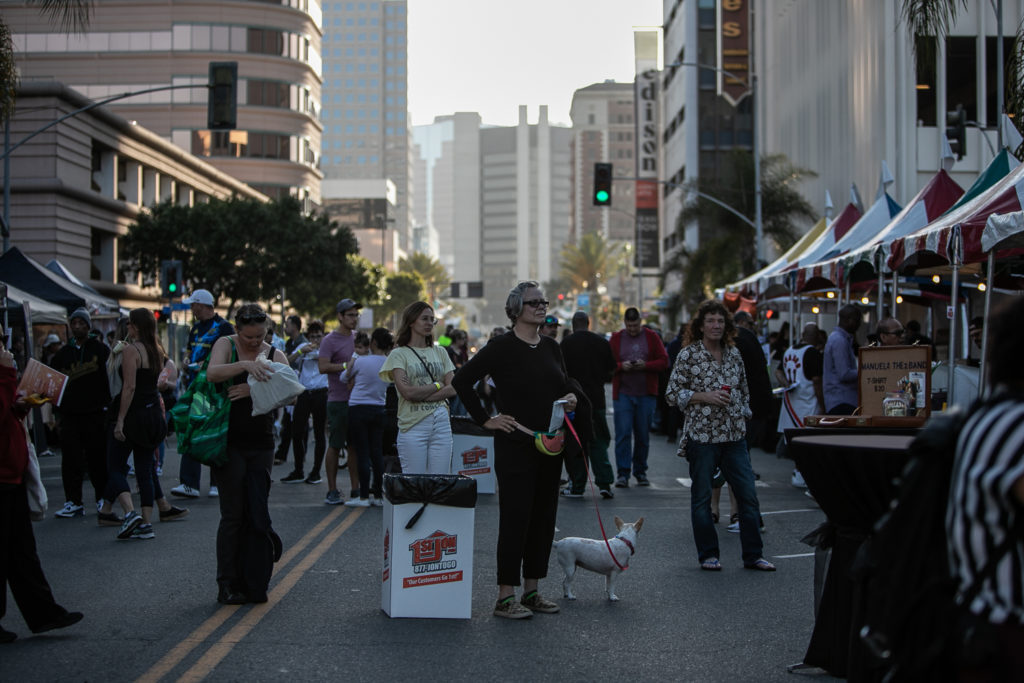Safety, Creative Thinking, and Community are Key
As the weather warms up, talk among policymakers has shifted toward processes for reopening the economy and safely phasing out the Safer At Home Order when the time comes. Consequently, questions and discussions around the role of public space in the recovery phase and beyond are coming to the fore.
Communal areas in urban centers like Downtown Long Beach range from pocket parks to promenades to street corners and sidewalks. After months of so-called social distancing, will those spaces still retain their essential functions as gathering places, and if so, what accommodations will be made to ensure the health and safety of the public? Furthermore, will changes to the use of these spaces during the public health crisis inform their use in the future, creating a new normal?

This year, many events like Taste of Downtown (pictured here in 2019) were canceled or converted to virtual events due to COVID-19. Event planners and public realm coordinators are considering the use and role of public space going forward.
Before addressing these larger questions, some are advocating to re-examine the way we think of social distancing. Mariah Hoffman, Placemaking Manager for the Downtown Long Beach Alliance (DLBA), is one of many public realm professionals who have adopted the phrase “physical distancing” in place of the more widely used “social distancing.”
“When you think about social distancing, you think about being socially isolated from other people – not just your friends and family, but also the neighbors and community members you run into while you’re out commuting, exercising, shopping, or gathering,” Hoffman said. “It implies a loss of social connection. But that’s not really the case; what we are doing is creating physical distance to maintain our health. Even in moments of physical solitude, opportunities still exist to maintain social connections, particularly through the use of technology.”
State and local leaders have indicated that there will be a phased-in approach to reopening the economy and public spaces. As these decisionsconsiderations are made, professionals whose work revolves around the public sphere are discussing best practices and considerations to be made moving forward.
“With many people working from home and not able to go to the office, events, or shopping, we already see a renewed feeling for the importance of public spaces and parks,” reflected Alan Pullman, Senior Principal of architecture firm Studio One Eleven and Chair-Elect for DLBA’s Board of Directors. “What is critical is that we rebuild trust in safely being able to enjoy public spaces again.”
Key in doing so, according to Pullman, is continuing to maintain public spaces so they are clean and safe, not only by sanitization but also by incorporating enhanced signage to alert the public to best health and safety practices.
Next, investments must be made in activities and programming to attract people back to Downtown’s open spaces. “These will start modestly and can include buskers, pop-up retailers, and small community events like open houses and temporary art installations,” Pullman suggested. “A promising plan would consist of temporarily closing streets as well as increasing pedestrian and seating spaces so that gatherings can occur while maintaining social distancing. Over time, the City should lift restrictions to open up the floodgates of community initiative and imagination.”
Coordinated marketing plans will be crucial in bringing people back to Downtown’s public spaces and sidewalks – critical activity for area businesses, Pullman noted.
The public health crisis and Safer At Home order have been difficult for everyone, but particularly for those who have no outdoor space to call their own and live in dense areas, Pullman said. “Providing spaces for all populations is going to be important. . . . Increasing public space in our denser parts of the city might be something to consider, whether it’s small plazas or courtyards or other elements that give people a sense of green space and serenity in a busy city.”
Aaron Rickel, Marketing Director for Pedal Movement – the firm that operates the City of Long Beach’s bicycle share program – noted that the Safer At Home order has had an interesting effect on the usage of city streets. With fewer motor vehicles on the road, Long Beach’s roadways have become more active with pedestrians and cyclists.
“A lot of people are turning to bicycles because it’s pretty easy to stay away from other people while cycling,” Rickel observed. “As we at some point shift back to a new normal, we should consider what we can do to preserve the accessibility that we’re seeing right now.”
The city’s bike share program has been suspended under the Safer At Home order, but Rickel and the Pedal Movement team have been working hard to prepare for the relaunch, whenever it comes. The key focus is on sanitation. “If people are going to feel comfortable using a bike other people have used, they want to be sure those bikes are really clean,” he noted. Pedal Movement is also investigating alternate payment procedures to reduce touchpoints and risk of contamination between users.
“As these conversations continue, DLBA’s Placemaking Department is working toward creative solutions to engage the community, planning virtual events, and making considerations for use of our public spaces as we recover,” Hoffman said.
“Our public spaces – our streets, parks, plazas, esplanades, and beaches – are our City’s shared assets. They are essential in making Long Beach the great City it is to live in, and they will require our renewed attention to recover and once again serve our common values,” Pullman concluded.
